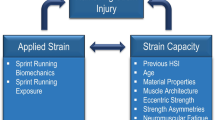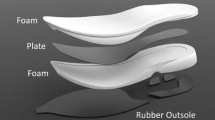Abstract
Accelerated rehabilitation after anterior cruciate ligament (ACL) reconstruction has become increasingly popular. Methods employed include immediate extension of the knee and immediate full weight bearing despite the risks presented by a graft pull-out fixation strength of 200–500 N. The purpose of this study was to calculate the tibiofemoral shear forces and the dynamic stabilising factors at the knee joint for the reasonably demanding task of downhill walking, in order to determine whether or not this task presented a postoperative risk to the patient. Kinematic and kinetic data were collected on six male and six female healthy subjects during downhill walking on a ramp with a 19% gradient. Planer net joint moments and mechanical power at the knee joint were calculated for the sagittal view using a force platform and videographic records together with standard inverse dynamics procedures. A two-dimensional knee joint model was then utilised to calculate the tibiofemoral shear and compressive forces, based on the predictions of joint reaction force and net moment at the knee. Linear envelopes of the electromyographic (EMG) activity recorded from the rectus femoris, gastrocnemius and biceps femoris muscles were also obtained. The maximum tibiofemoral shear force occurred at 20% of stance phase and was, on average, 1.2 times body weight (BW) for male subjects and 1.7 times BW for female subjects. The tibiofemoral compressive force was 7 times BW for males and 8.5 times BW for females during downhill walking. The hamstring muscle showed almost continuous activity throughout the whole of the stance phase. The gastrocnemius muscle had its main activity at heelstrike, with a second brust during the late stance phase. Knee joint shear force predictions of approximately 1000 N for a 70-kg subject greatly exceed the strength of a typical ACL graft fixation and muscular stabilisation of the knee is therefore vital to joint integrity. The hamstring muscle shows almost continuous activity during the stance phase and thereby affords some stability, but the gastrocnemius is also seen to be an important stabiliser of the knee joint in the presence of increased shear forces during early stance. Associated stability to the knee joint is indicated by compressive loadings of 7–8 times BW across the tibiofemoral joint. Whereas under normal circumstances there is sufficient dynamic joint stabilisation during downhill walking, the muscular impairment often arising postoperatively from disturbed proprioception could endanger an ACL graft. Therefore downhill walking should be avoided during the postoperative phase in order to protect the reconstruction.
Similar content being viewed by others
References
Andriacchi PT, Mikosz RP (1991) Musculoskeletal dynamics, locomotion and clinical applications. In: Mow VC, Hayes WC (eds) Basic orthopaedic biomechanics. Raven Press, New York, pp 51–92
Baratta R, Solomonow M, Zhou BH, Letson D, Chuinard R, D'Ambrosia R (1988) Muscular coactivation. The role of the antagonist musculature in maintaining knee stability. Am J Sports Med 16:113–122
Clancy WG, Narecchania MS, Rosenberg TD, Gmeiner JG, Wisnefske DD, Lange TA, Wisconsin M (1981) Anterior and posterior cruciate ligament reconstruction in rhesus monkeys. J Bone Joint Surg [Am] 63:1270–1284
Draganich LF, Jaeger RJ, Kralj AR (1989) Coactivation of the hamstrings and quadriceps during extension of the knee. J Bone Joint Surg [Am] 71:1075–1081
Holmes PF, James SL, Larson RL, Singer KM, Jones DC (1991) Retrospective direct comparison of three intraarticular anterior cruciate ligament reconstructions. Am J Sports Med 19:596–599
Hsich HH, Walker PS (1976) Stabilizing mechanisms of the loaded and unloaded knee joint. J Bone Joint Surg [Am] 58:87–93
Johansson H, Sjölander P, Sojka P (1991) A sensory role for the cruciate ligaments. Clin Orthop 268:161–171
Kurosaka M, Yoshiya S, Andrisch JT (1987) A biomechanical comparison of different surgical techniques of graft fixation in anterior cruciate ligament reconstruction. Am J Sports Med 13:225–229
Kuster M, Sakurai S, Wood GA (1993) Kinematics and kinetics of downhill versus level walking. Proceedings of the 14th International Society of Biomechanics Congress, Paris, pp 732–733
Mann R, Inman VT (1964) Phasic activity of intrinsic muscles of foot. J Bone Joint Surg [Am] 46:459–481
Markolf KL, Graff-Radford A, Amstutz HC (1978) In vivo knee stability: a quantitative assessment using an instrumented clinical testing apparatus. J Bone Joint Surg [Am] 60:664–674
Markolf KL, Gorek JF, Kabo M, Shapiro MS (1990) Direct measurement of resultant forces in the anterior cruciate ligament. J Bone Joint Surg [Am] 72:557–567
Morrison JB (1969) Function of the knee joint in various activities. Bio Med Eng 4:573–580
Morrison JB (1970) The mechanics of muscle function in locomotion. J Biomech 3:431–451
Nisell R (1985) Mechanics of the knee. A study with joint load and muscle activity with clinical implications. Acta Orthop Scand [Suppl] 216
Noyes FR, Grood ES (1976) The strength of the anterior cruciate ligament in humans and rhesus monkeys. Age related and species related changes. J Bone Joint Surg [Am] 58:1074–1082
Sakurai S, Kuster M, Wood GA (1993) Measurement system of joint kinetics in downhill walking. Proceedings of the 14th International Society of Biomechanics Congress, Paris, pp 1166–1167
Shelbourne KD, Nitz P (1990) Accelerated rehabilitation after anterior cruciate ligament reconstruction. Am J Sports Med 18:292–299
Shino K, Inoue M, Horibe S, Nagano J, Ono K (1988) Maturation of allograft tendons transplanted into the knee. J Bone Joint surg [Br] 70:556–560
Tokuhiro A, Nagashima H, and Takechi H (1985) Electromyographic kinesiology of lower extremity muscles during slope walking. Arch Phys Med Rehabil 66:610–613
Wilson DR, Zavatsky AB, O'Connor JJ (1993) Cruciate ligament forces at the knee in gait: parameter sensitivity and effects of ligament elasticity. Proceedings of the 14th Internatinal Society of Biomechanics Congress, Paris, pp 1466–1467
Winter DA (1990) Biomechanics and motor control of human movement. Wiley Interscience, New York
Winter DA (1991) The biomechanics and motor control of human gait: normal elderly and pathological University of Waterloo Press, Waterloo, Ontario
Woo SL-Y, Hollis MJ, Adams DJ, Lyon RM, Takai S (1991) Tensile properties of the human femur—anterior cruciate ligament—tibia complex. The effects of specimen age and orientation. Am J Sports Med 19:217–225
Yamamoto N, Ohno K, Kuriyama H, Yasuda K, Kaneda K (1993) Effects of stress shielding on the mechanical properties of rabbit patellar tendon. J Biomech Eng 115:23–28
Author information
Authors and Affiliations
Additional information
This research was conducted in the Department of Human Movement at The University of Western Australia. Perth during the first author's tenure as a Visiting Research Fellow supported by a scholarship of the Swiss Orthopaedic Association (SGO)
Rights and permissions
About this article
Cite this article
Kuster, M., Wood, G.A., Sakurai, S. et al. Downhill walking: A stressful task for the anterior cruciate ligament?. Knee Surg, Sports traumatol, Arthroscopy 2, 2–7 (1994). https://doi.org/10.1007/BF01552646
Issue Date:
DOI: https://doi.org/10.1007/BF01552646




